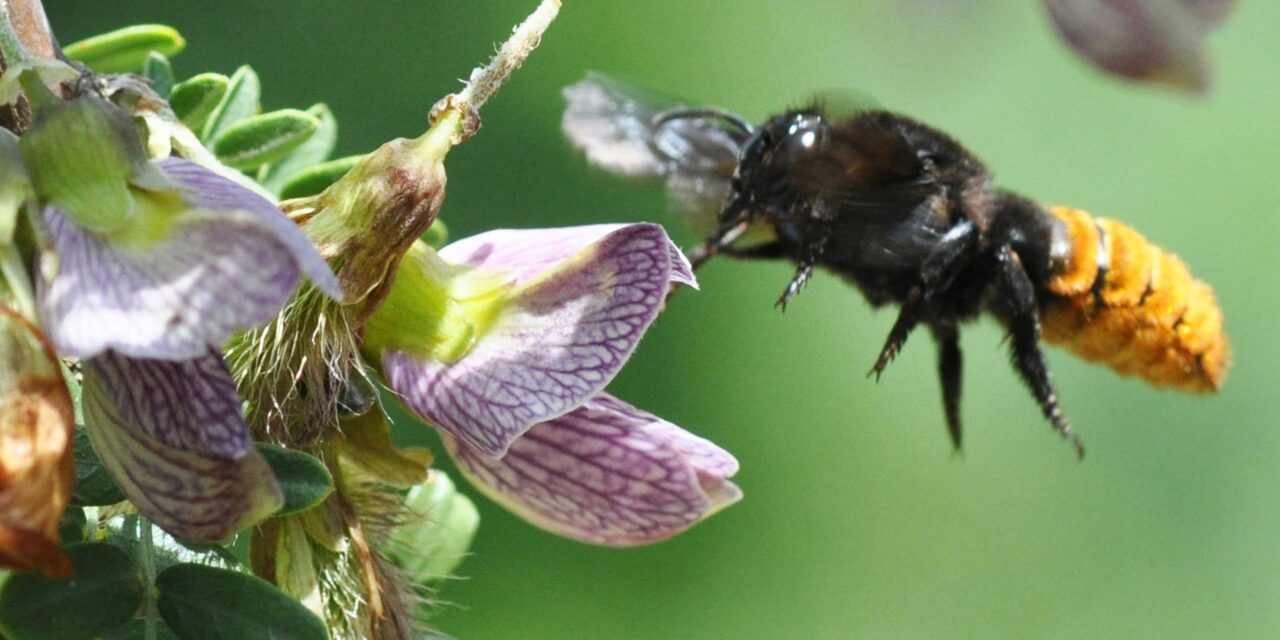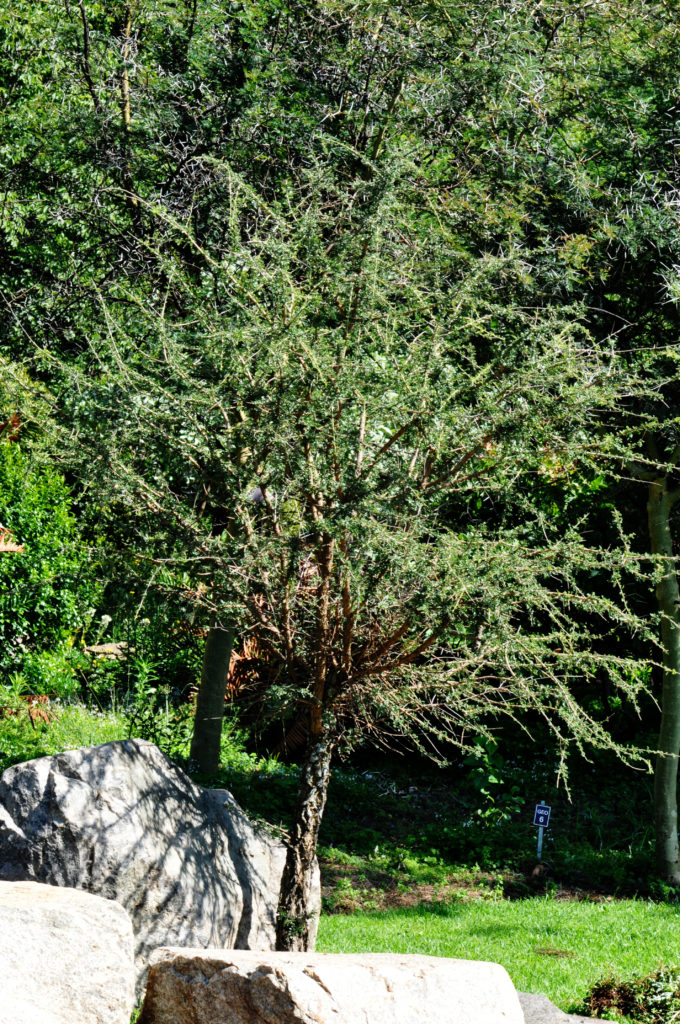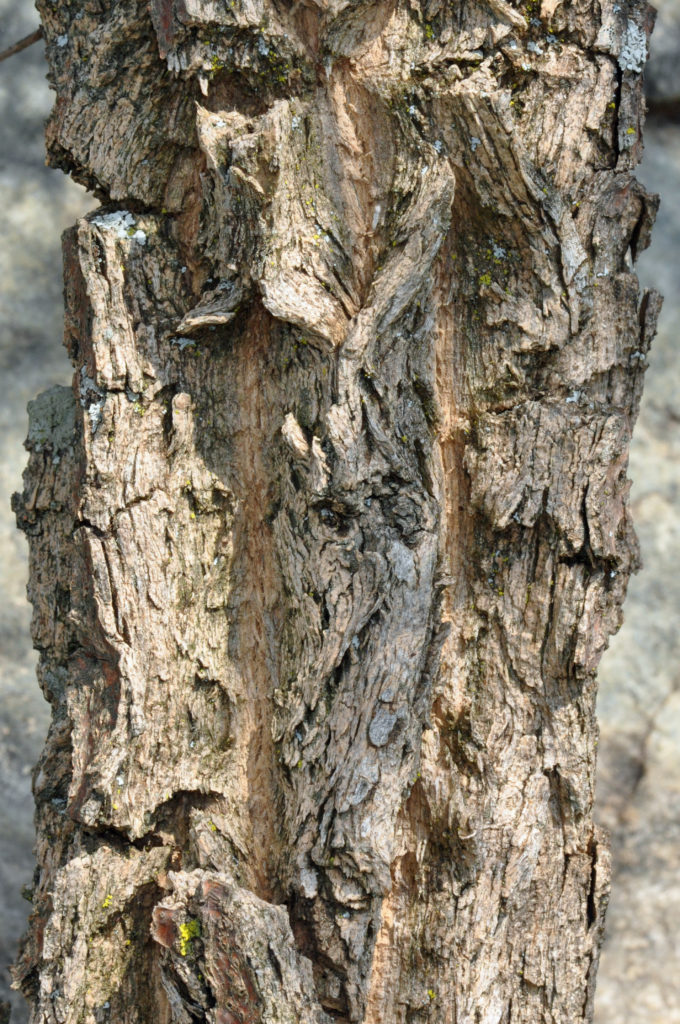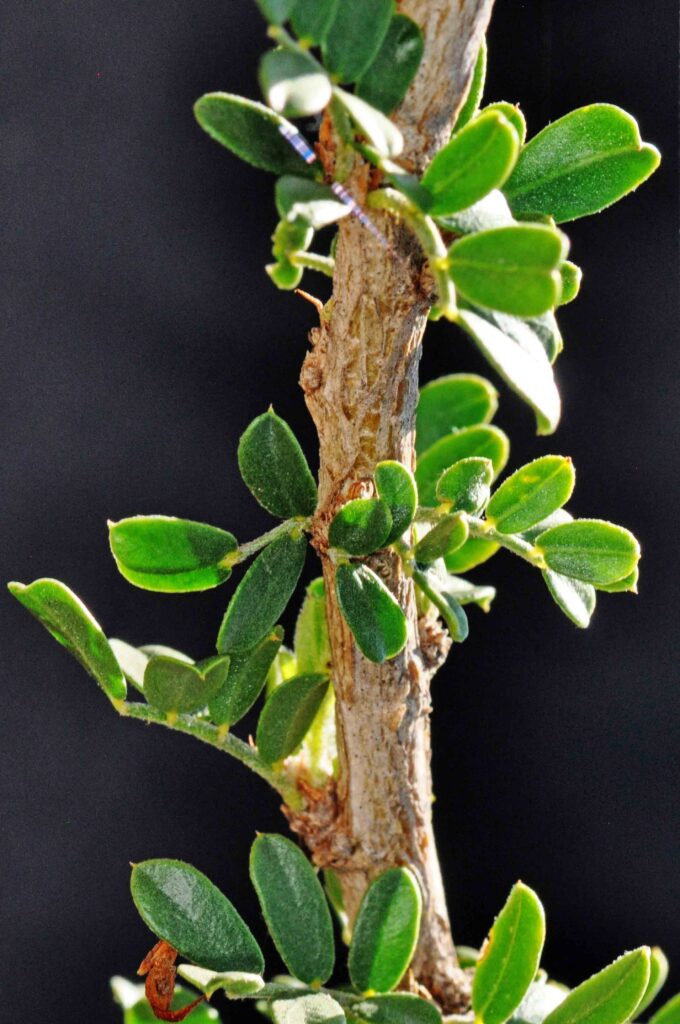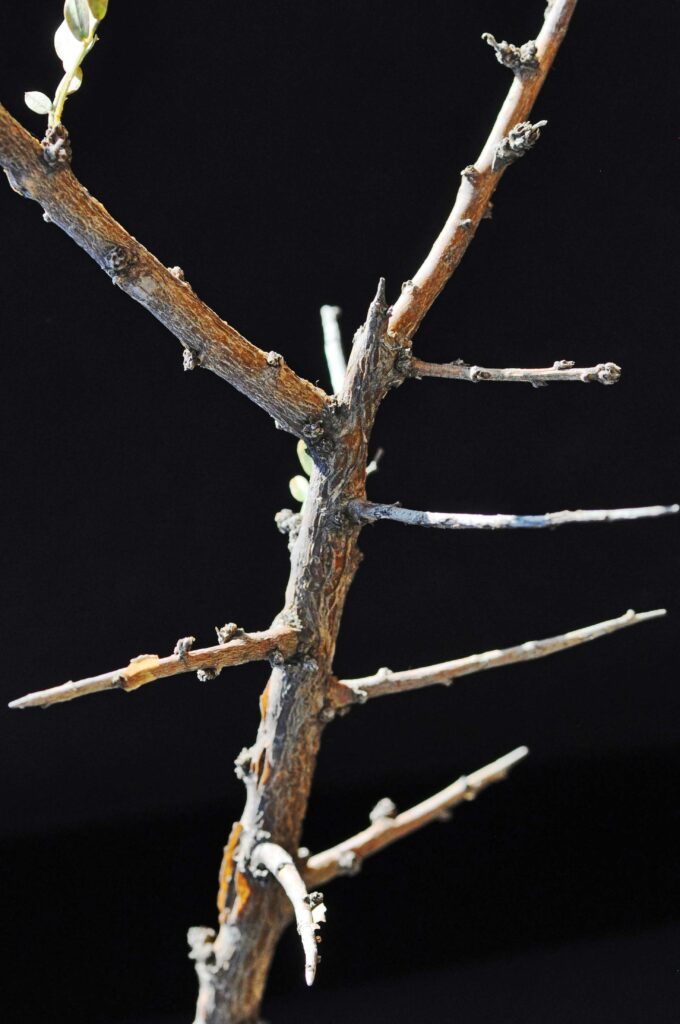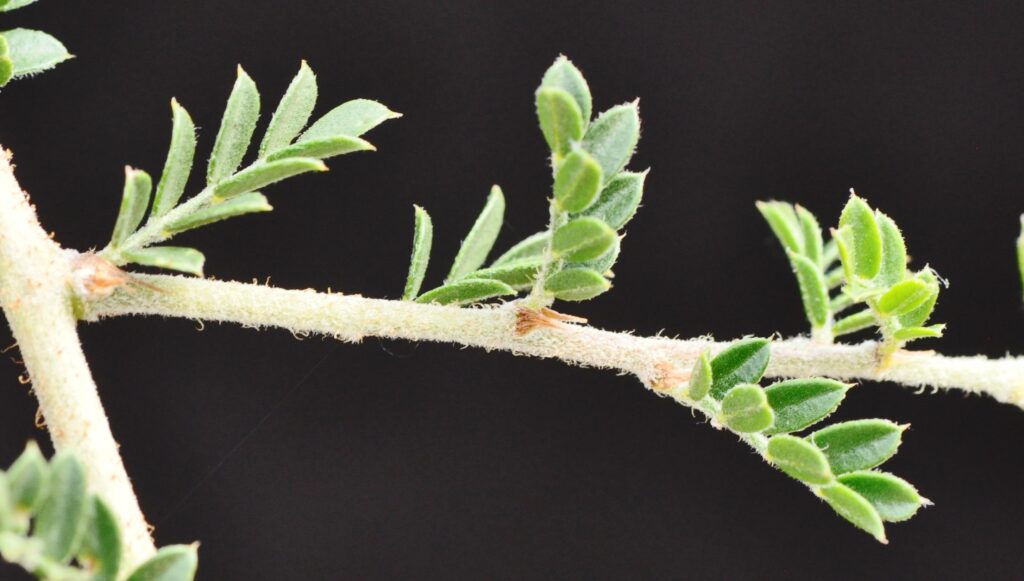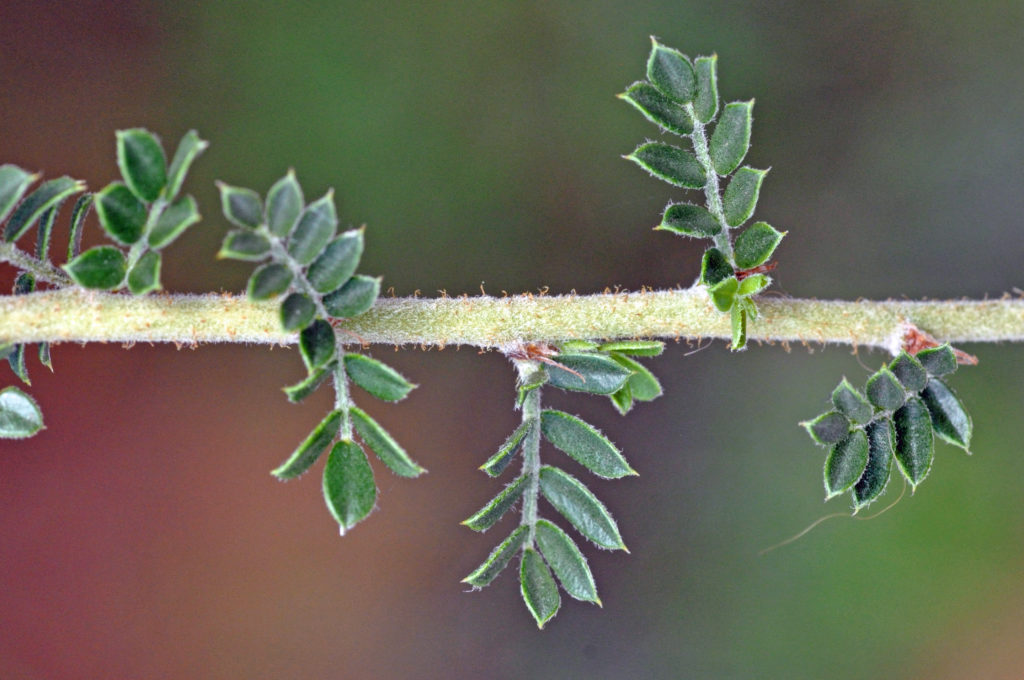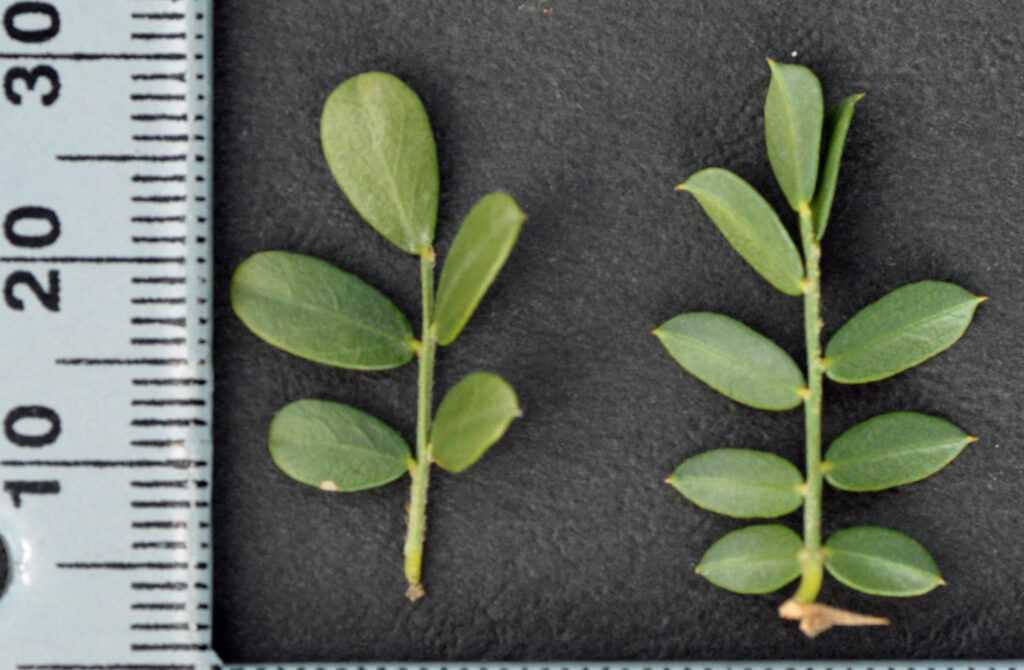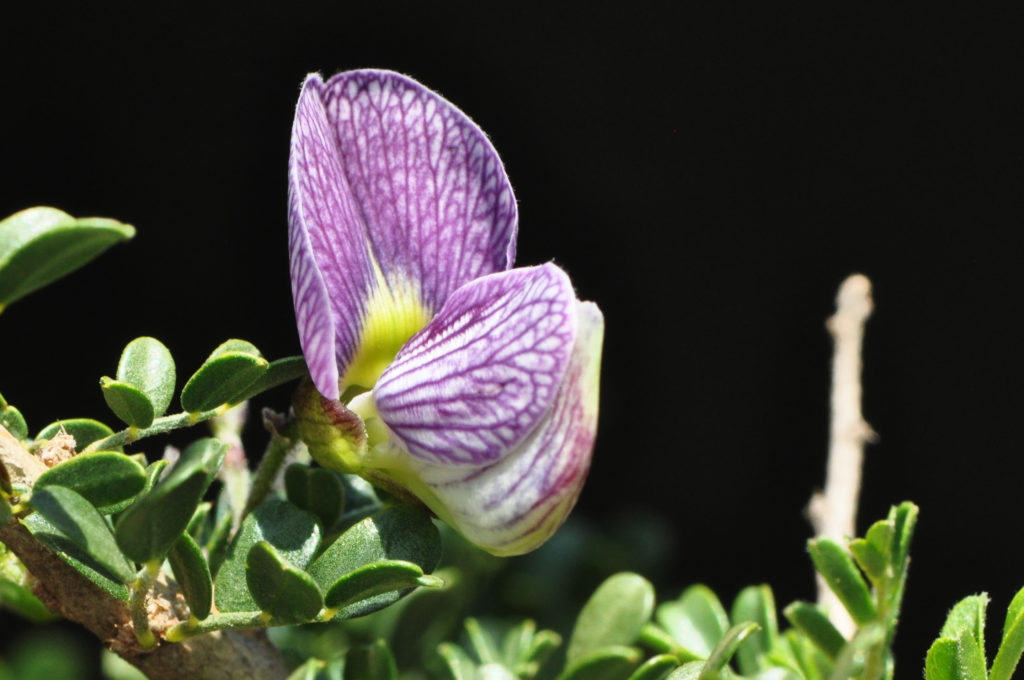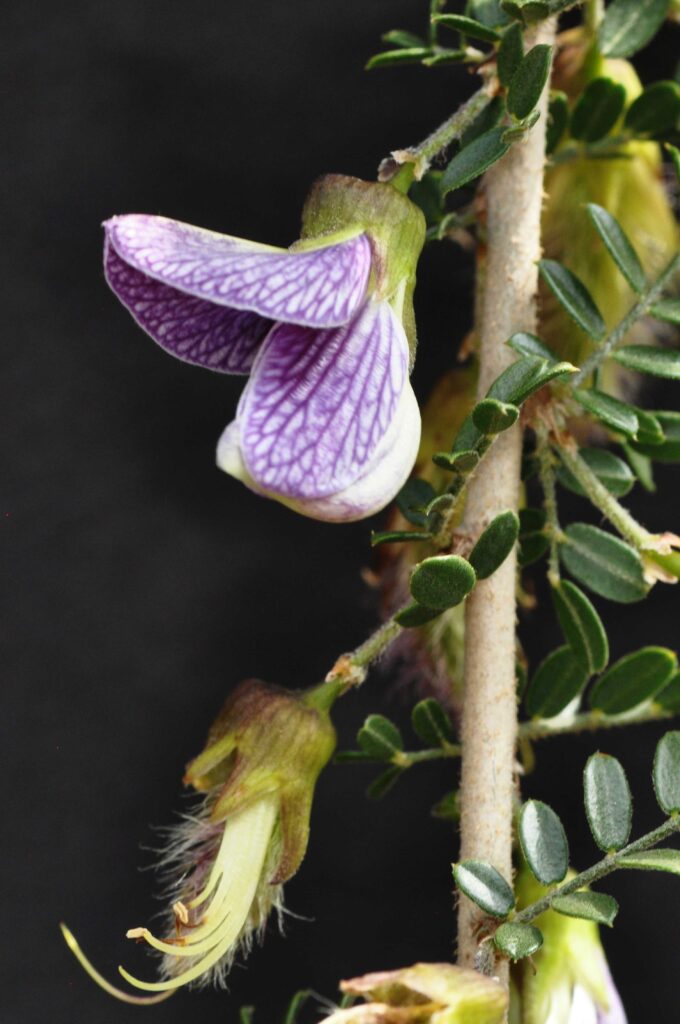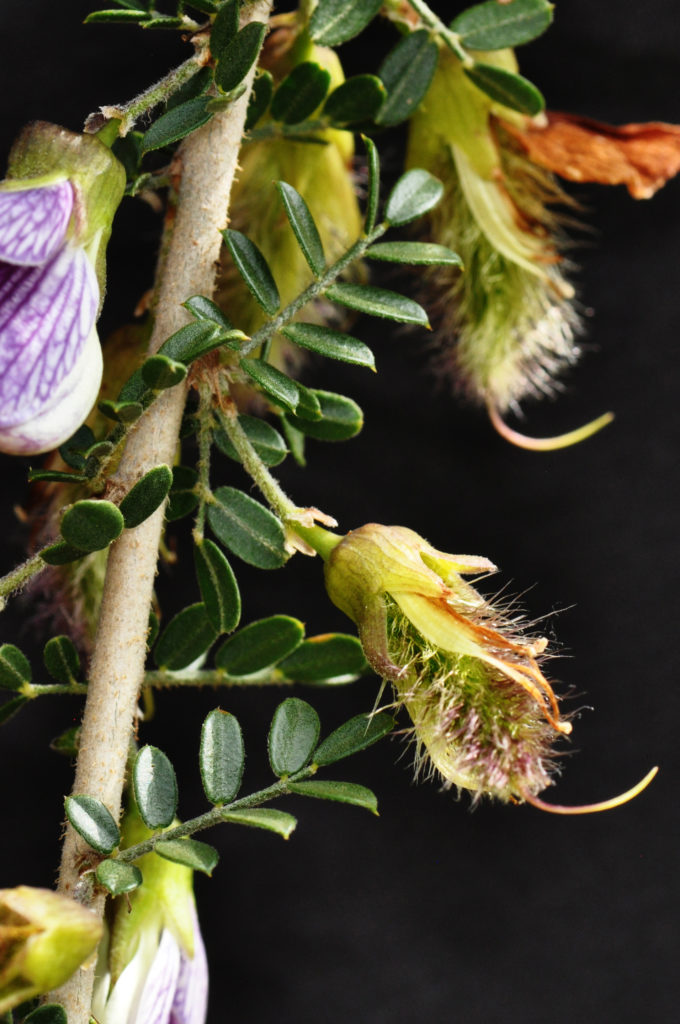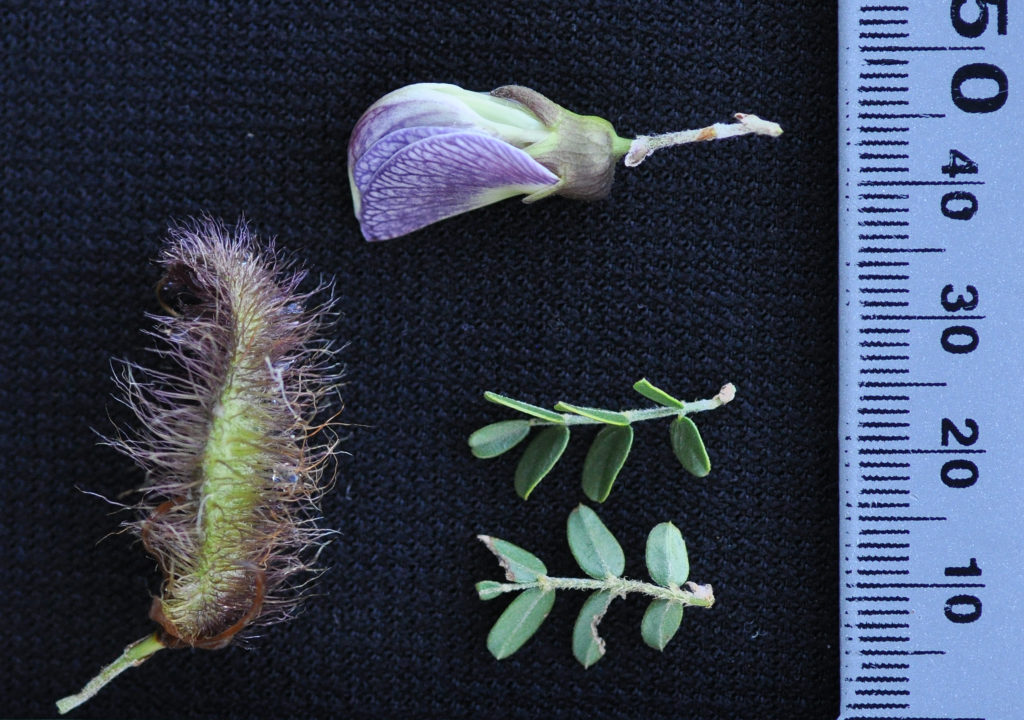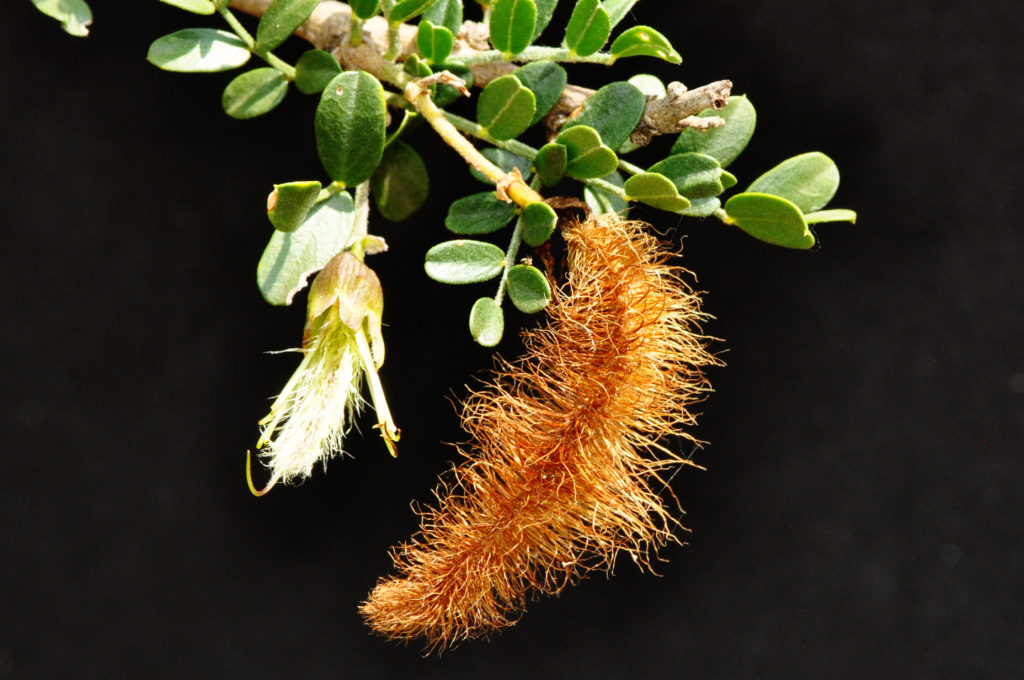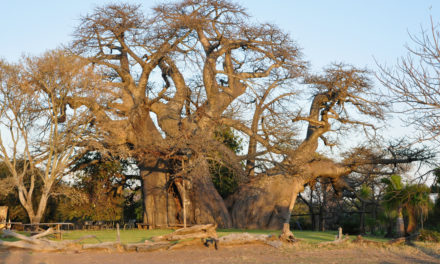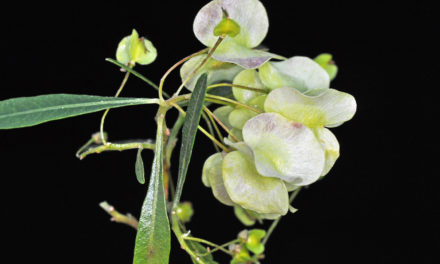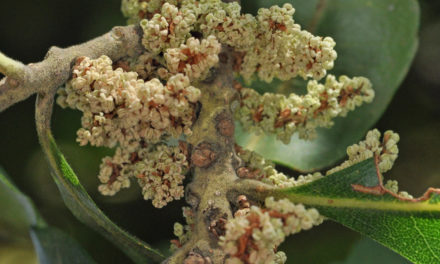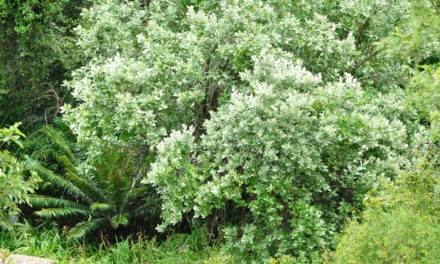General Info – summary
This spiny shrub or small Tree, with its ridged branches and deeply fissured corky bark, is up to 5m high. The small imparipinnate Leaves are on hairy spur branches. The zygomorphic Flowers are bisexual. Here the pea-shaped, light blue petals have a much darker network of attractive violet veins running through them. Fruit is an indehiscent distinctly hairy pod containing light brown compressed seeds.
Description
Ormocarpum trichocarpum
Previous Names: Diphaca trichocarpa, Ormocarpum setosum.
SA Tree No. 230.
Common names: (Afr) Harige Rusperboontjie, Krulrusperboontjie, Rusperboontjie. (Eng) Caterpillar Bush, Caterpillar-pod, Hairy Caterpillar-pod. (isiZulu) Isithibane, Umsindandlovana. (Northern Sotho) Mosepe. (Setswana) Nsekenseke. (siSwati) Isitsibane, Isitibane, Sitsbane. (Tshivenda) Mugogodwane, Muthari.
Family: Fabaceae, or Leguminosae (Pea, bean or legume family). After the Orchidaceae and the Asteraceae, the Fabaceae is the third largest Angiosperm (flowering plants) family with 700+ genera and close to 20 000 species. Local Tree genera on this website include Acacia (Vauchellia, Senegalia), Albizia, Bauhinia, Bolusanthus, Burkea, Calpurnia, Colophospermum, Cordyla, Cyclopia, Dichrostachys, Erythrina, Erythrophleum, Faidherbia, Indigofera, Mundulea, Philenoptera, Piliostigma, Schotia and Xanthocercis. The Fabaceae are recognisable by their fruit and by their pinnately compound Leaves. Leaves may also be simple – even bilobed and usually have stipules – some of which may be spinescent. Leaflets are usually entire. Flowers are bisexual and bracteate. Regular flowers usually have 4-5 sepals and the same number of petals. Irregular flowers have 4-5 sepals and 5 or less petals. Stamens have anthers that have 2 pollen sacs and there are usually at least twice the number of stamens as petals – often 10. The superior Ovary has 1 locule containing 1 or more ovules. The Stigma and Style are simple. The single carpel develops into the Fruit, which is usually a pod. The mature pods dehisce or break into segments. Seeds vary.
Name derivation: Ormocarpum – neckless fruit – has constrictions between seeds (slightly so in South Africa). trichocarpum – bristly / hairy fruit. There are about 20 species in the genus and 2 in southern Africa. The other species is Ormocarpum kirkii.
Conservation: National Status: L C. (Least Concern). 2005 (W. Foden and L. Potter).
Tree
This large slender shrub may also be a small Tree with a small, sparse crown (photo 915). It may reach 5m high but is usually shorter. Considering the tree size, the very thick blackish to greyish-brown, corky and deeply fissured Bark is unexpected (photo 908) and distinctive for a small tree. Spines may be present (photo 701). Branches are rigid and arching. Young branches are purplish and become creamy white (photo 906). Short, light, curly hairs are common (photo 297 – under Leaves).
- 915. 2014/11/25. Walter Sisulu NBG. Photo: David Becking.
- 908. 2015/02/24. Walter Sisulu NBG. Photo: David Becking.
- 906. 2014/11/25. Walter Sisulu NBG. Photo: David Becking.
- 701. 2016/08/30. Walter Sisulu NBG. Photo: David Becking.
Leaves
The small – (up to 35mm long) Leaves (photo 283) are imparipinnate (compound leaf ending in a single terminal leaflet). Up to 4 tend to be clustered on older branches and sort stumpy side shoots that end in spines (photo 701 under Tree). Each leaf has 2-6 pairs of opposite or nearly so Leaflets and a single terminal one. Each leaflet is elliptic to oblong and up to 11 x 4mm. The Upper surface becomes dark green (photo 294). The Lower surface frequently has white hairs. Here, with the aid of a hand lens, many compact minute black dots are usually visible. The Apex is rounded and mucronate (ending abruptly in a sharp tip – photo 294) and the Base is rounded. The thick Petiole (leaf stalk) is up to 6mm long. Both the petiole and rachis (main axis bearing flowers or leaflets) are hairy (photo 297). Petiolules (stalks of leaflets) are short and thickened (photo 283). The common Midrib is hairy. The Margin is not wavy and is entire (with a continuous margin, not in any way indented). The small sharp pointed Stipules (basal appendages of the petiole) are orange /red (photo 297) to brownish and initially visible. They are caducous (easily detached and shed at an early stage).
- 297. 2015/02/24. Walter Sisulu NBG. Photo: David Becking.
- 294. 2015/02/24. Walter Sisulu NBG. Photo: David Becking.
- 2283. 2015/02/24. Walter Sisulu NBG. Photo: David Becking.83 2015.02.24 Walter Sisulu NBG. Photo: David Becking.
Flowers
The often solitary, attractive, bisexual Flowers are zygomorphic (floral parts unequal in size or form so that the flower is capable of division into essentially symmetrical halves by only one longitudinal plane passing through the axis). Flowers are typically pea shaped. They are about 1,3cm long and up to 3 are borne in leaf axils, on hairy Pedicels (stalks of single flowers photos 271 & 272). Bracts (much-reduced specialised leaves) are clearly visible on the pedicles (photos 271 & 272). The Calyx (photo 271) has a broadly bell-shaped tube at the base, from which the 5 green Sepal lobes extend (photos 271 & 114 – under Fruit). The uppermost of the 5 short lived Petals, the Vexillum or standard petal, is the largest and stands almost vertically and at right angles to the other 4. Its central base is yellow and may be slightly white tipped (photo 617). At the base of the flower are 2 joined, incurved Keel petals which enclose the stamens and the pistil. On either side of the keel petals, are the 2 Wing petals which occur below the standard petal (photo 271). All petals are light blue with a much darker network of attractive violet to purple veins running through them (photo 617). Petals are discarded soon after fertilization (photo 271). In this photo, the inflexed (bent or curved inwards) Style is visible. The 10 Stamens are monadelphous (stamen filaments that are all fused for the greater part of their length, so forming a tube around the style). Here they split to give 2 bundles of 5 each. The Anthers are uniform. The Pistil (a unit of the Gynoecium, the female element of the flower, composed of the Ovary, Style and Stigma) contains a superior sessile Ovary and an inflexed Style (photo 271). The style ends in a single Stigma. The remains of the style are clearly visible in developing fruit (photo 272). (Sep-Mar).
- 617. 2014/12/23. Walter Sisulu NBG. Photo: David Becking.
- 271. 2015/02/24. Walter Sisulu NBG. Photo: David Becking.
- 272. 2015/02/24. Walter Sisulu NBG. Photo: David Becking.
Fruit
Both flowering and fruiting are irregular. The small, flattish Fruit is a Pod that is up to 5cm long. It is usually straight but may be curved. What makes this tree easy to recognise, are the unusual long, stiff and shaggy golden brown to yellowish bristles that cover the pod (photo 284). This is the origin of the common names: “Caterpillar Bush”, “Hairy Caterpillar-pod” and “Caterpillar-pod”. Flowers and fruit may be visible at the same time. If the hairs are removed, the pod can be seen to be constricted between the light brown compressed seeds. (Oct-Mar).
- 114. 2016/12/13. Walter Sisulu NBG. Photo: David Becking.
- 284. 2015/02/24. Walter Sisulu NBG. Photo: David Becking.
Distribution & Ecology
These plants occur from close to sea level to the Highveld and escarpment. They occur in savanna (is a rolling grassland scattered with shrubs and isolated trees, which can be found between a tropical rainforest and desert biome) and on rocky hillsides within an altitude range of 50 to 1 600m. They are also common in brackish (slightly salty) and shallow soils. In the South Africa, they occur naturally in KwaZulu-Natal, Limpopo and Mpumalanga. Beyond our borders, they occur in Swaziland, Botswana, Zimbabwe, Mozambique, Ethiopia and Rwanda and Sudan. The Leaves are browsed by herbivores like kudu, black rhino and giraffe. Giraffe and rhino also consume the young Branches.
Ethnobotany
The white, tough Wood is finely textured but of insufficient size to be of much use. Farm animals browse the Leaves. Plant extracts have shown some activity against malaria and bacteria. Bark extracts are used locally as an emetic.
References
Boon, R. 2010. Pooley’s Trees of eastern South Africa. Flora and Fauna Publications Trust, Durban.
Burrows, J.E., Burrows, S.M., Lotter, M.C. & Schmidt, E. 2018. Trees and Shrubs Mozambique. Publishing Print Matters (Pty) Ltd. Noordhoek, Cape Town.
Coates Palgrave, M. 2002. Keith Coates Palgrave Trees of Southern Africa, edn 3. Struik, Cape Town.
Foden, W. & Potter, L. 2005. Ormocarpum trichocarpum (Taub.) Engl. National Assessment: Red List of South African Plants version 2020.1. Accessed on 2023/10/02.
Lawrence, G. H. M, 1951. Taxonomy of Vascular Plants. The Macmillan Company, New York. Tenth Printing 1965.
Palmer, E. & Pitman, N. 1972. Trees of southern Africa. Balkema, Amsterdam, Cape Town.
Schmidt, S. Lotter, M. & McCleland, W. 2002. Trees and Shrubs of Mpumalanga and the Kruger National Park. Jacana, Johannesburg.
http://www.operationwildflower.org.za/index.php/albums/trees/ormocarpum-trichocarpum-il-1-3112
http://www.zimbabweflora.co.zw/speciesdata/species.php?species_id=130370
http://posa.sanbi.org/flora/browse.php?src=SP

